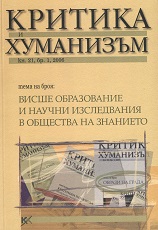Пътища за реформиране на университетското класическо образование
Ways of Reforming Higher Classical Education
Author(s): Violeta Gerdjikova, Yoana Sirakova, Nikolay SharankovSubject(s): Cultural Essay, Political Essay, Societal Essay
Published by: Фондация за хуманитарни и социални изследвания - София
Keywords: reform; higer education; classical studies; curricula structures; university
Summary/Abstract: The paper is dealing with some general trends in reforming higher classical education, based on comparative and contrastive analyses of several curricula from different universities in Eastern Europe. The programs in Classics of Moscow State University, Skopje State University, Tbilisi State University, Harkov National University, Sofia State University are analyzed in the perspective of reforms in higher education in post-communist countries. Integration of different models and traditions in teaching and learning are among the great concerns of newly developed universities curricula, that mark a new stage in re-thinking the concepts of education and teaching. Renewal of practices and methods is connected to changes in roles of students and professors, of focuses and accents in both social context and process of education. A generation ago Greek and Latin were core subjects in the curriculum of most Western secondary schools and held a central place within the Arts Faculties of the universities. Their educational value was accepted without question and they were seen as the ideal preparation for a variety of careers. The last thirty years have brought a dramatic change. Universities in transition in Eastern Europe had to face serious problems, and subjects like Greek and Latin have to surrender space to the new disciplines and have to compete with them. A new preoccupation with economic growth and technical advance and a new sense of relevance and utility in education, focused on the fastest means of acquiring specific marketable skills, questioned the value of all studies that have an aura of the academic and intellectual about them and that seem likely to produce a cultural and intellectual elite rather than a technically proficient and technologically innovative work-force. Some general questions are put and problems to be solved, e.g. interdisciplinarity in education, isolation of the discipline from other university subjects and the world outside, isolation of teachers from their colleagues, opening to new innovative models and ideas in education as a whole. A comparative analysis of curricula structures of the above mentioned universities is made and several criteria are outlined, designating different levels of reforming the discipline of Classical Studies. The paper is presenting to readership five figures, dealing with heterogeneous aspects of curricula structures. The formal re-organization of curricula is a major problem in some universities. Nevertheless, the quantitative changes in Classics programs bring along also qualitative re-framing of the courses content, more flexible ways and methods of teaching, a greater perspective for innovations and collaborations among both disciplines themselves and professors.
Journal: Критика и хуманизъм
- Issue Year: 2006
- Issue No: 21
- Page Range: 347-359
- Page Count: 13
- Language: Bulgarian
- Content File-PDF

